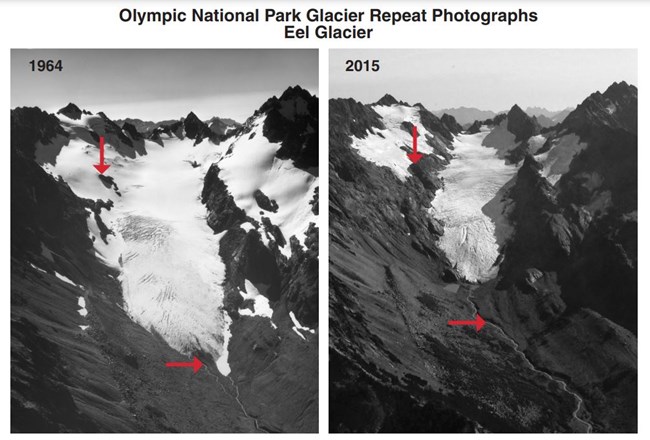
"Requiem for a Glacier uses 100 years of climate data from Hurricane Ridge. The piece is created in three layers. The bass line represents Mount Anderson, solid and unchanging. The voices represent the exponential rise in ambient temperature from 1922 to 2022. The melody line, Requiem Aeternam from the centuries-old Latin Mass for the Dead, is the glacier itself. Each iteration of the melody shortens as the Eel Glacier melts, ending in a final, single tone." -Thomas Peters 
Meet the artist: Thomas PetersComposer and GRAMMY© nominated performer Thomas Peters is known for intricate electronic soundscapes, often accompanying classic silent films. Thomas’s latest work, Requiem for a Glacier, was commissioned in 2022 by the National Park Service as part of Olympic National Park’s Terminus Project. This new work is an audio depiction of a dying glacier, and will form the basis for his new album, a full requiem entitled Glacier that is slated for release in late 2023. Thomas’ work builds on Paul Hindemith’s concept of Gebrauchsmusik, or “needed music.” Gebrauchsmusik is the musical equivalent of functional art—music that serves a specific purpose. His 2020 release Sleep Music: Rain is an album of ambient music that is designed to help people who have trouble sleeping. His 2021 album Lamentations was meant to give people the space to grieve—something that is particularly relevant in the aftermath of COVID-19. Lamentations was awarded a 2020 Arts and Accessibility grant from the National Arts and Disability Center. The album was released in February 2021. Thomas’s 2014 GRAMMY® nominated recording of John Cage’s The Ten Thousand Things on the MicroFest label with acclaimed pianists Aron Kallay and Vicki Ray, legendary percussionist William Winant, and a recently discovered recording of John Cage himself performing 45’ for a Speaker was the first American recording of this seminal work. He has performed as a soloist with Ensemble Oh-Ton, People Inside Electronics, MicroFest, and the Schindler House and many others, and has been featured on Nordwest Radio in Hamburg, Germany.
"It was my neurodiversity that led me to discover the double bass in elementary school. While my fellow fourth-graders were crowding around the violins, the double bass sat alone in a corner. I didn’t want the bass to feel bad, so I brought it home and used it to make scary sounds for a Halloween tape. This pivotal experience taught me that the overlooked double bass had an extraordinary range of expression. "As an adult, I became a double bass soloist who specialized in performing, recording, and internationally touring works by avant-garde composers such as John Cage, Chinary Ung, and Hanne Darboven. I had learned Max/MSP and assembled a portable performing rig so that I could perform new music written for double bass and computer. "At the age of 50, I embarked on a new role as a composer. Formally composing music showed me that my extensive experience in performing the works of others had taught me a lot about how music is put together. I have now devoted my artistic resources to using the latest technology to create immersive sound worlds . "As a person on the autism spectrum, I speak for the community by representing how to turn painful challenges into unusual strengths. Looking forward, I’m planning to combine music with forms of storytelling to create new sound worlds with 3D audio. Music has its roots in narrative, and I am interested in exploring how music and stories can be intertwined to help people find common ground." 
More about Eel GlacierTucked beneath the steep ridges of Mount Anderson, the Eel is one of two glaciers that Olympic National Park scientists measure annually to assess changes and calculate water contributions to park rivers. Arrows in identical locations illustrate thinning and some retreat of this north-facing glacier, though not as much as the south-facing Anderson Glacier, located on the opposite side of Mount Anderson. 1964, 2010 and 2015 close up photos reveal a small tarn where there once was ice. 
|
Last updated: August 21, 2023
